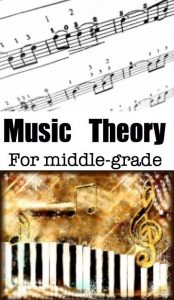 Music Theory Introduction for middle-grade, is an introduction to music theory, explaining the basics, first principals, in simple, easy to understand terms, suitable for middle-grade. This first volume in the series covers pitch and pitch notation, and major scales and keys including the circle of fifths.
Music Theory Introduction for middle-grade, is an introduction to music theory, explaining the basics, first principals, in simple, easy to understand terms, suitable for middle-grade. This first volume in the series covers pitch and pitch notation, and major scales and keys including the circle of fifths.
This is the first in a series of three Music Theory books by the authors, the other two are available on FKB here:
Music Fundamentals 2 Rhythm and Meter – middle-grade music theory
Music Fundamentals 3 Minor Scales and Keys – music theory for middle grades
Contents of Music Theory Introduction for middle-grade – Pitch and Major Scales and Keys
1 Introduction to Pitch Notation in Music ………………………..1
2 Clef ……………………………………………………………………..7
3 Introduction to the Piano Keyboard ……………………………19
4 Pitch: Sharp, Flat, and Natural Notes ………………………….25
5 Chromatic and Diatonic Half Steps ……………………………..29
6 Octave Designations in Music ……………………………………33
7 Key Signature ………………………………………………………35
8 Major Keys and Scales ……………………………………………41
9 Scale Degrees of the Diatonic Scale …………………………..47
10 Enharmonic Spelling …………………………………………….51
11 The Circle of Fifths ……………………………………………..59
Index …………………………………………………………………..65
Attributions …………………………………………………………..66
Sample Text from Music Theory Introduction for middle-grade – Pitch and Major Scales and Keys
Introduction to Pitch Notation in Music
Music is principally written with symbols specifying pitch and symbols specifying timing. Symbols indicating pitch give instructions on whether sounds are high or low or anywhere in between. Symbols indicating timing provide instructions on when and how long to play or sing a sound. These symbols are combined in ingenuous ways for music notation. When you master the fundamentals of music literacy, you will be able to read much of the music performed in the world today. The notation is commonly termed Western Musical Notation.
In this module we will present pitch notation. Pitch is a word we use for indicating where a note lies in a spectrum or range of musical tones. Musical pitches are designated by an alphabet letter or sometimes by a solfège syllable.
The musical alphabet uses letters A B C D E F G. Common solfège syllables are: Do Re Mi Fa Sol La Ti. In many countries the solfège syllables are employed to designate pitches. For instance, in France, Do is the name for C, Re for D, etc. This system of labeling pitches is termed xed Do, since Do always designates the note C. In America we most commonly designate pitches by their alphabet letter name.
The musical alphabet repeats throughout the range or register of music. For instance, notice that the piano keyboard below has a repeating musical alphabet (given below the keyboard in Figure 1):
<End of Page 1>
Download the full book on the buttons below. Readonline on our flipbook, or see the text online here: https://cnx.org/contents/auvTxjgB@1.11:SsLWdSJj@15/Duration-Note-Lengths-in-Written-Music
Sponsored Links:
If you sign up through these links, it doesn’t cost you any extra, but FKB receives a small donation, which helps us move towards our aim of
FREE Hardcopies!
All our posts are checked by Grammarly, the FREE online grammar checker (We still receive a donation even if you only sign up for the free account :-):

This site is hosted by Bluehost:

Leave a comment (it won’t be public) if you want help getting your own website cost-effectively.










